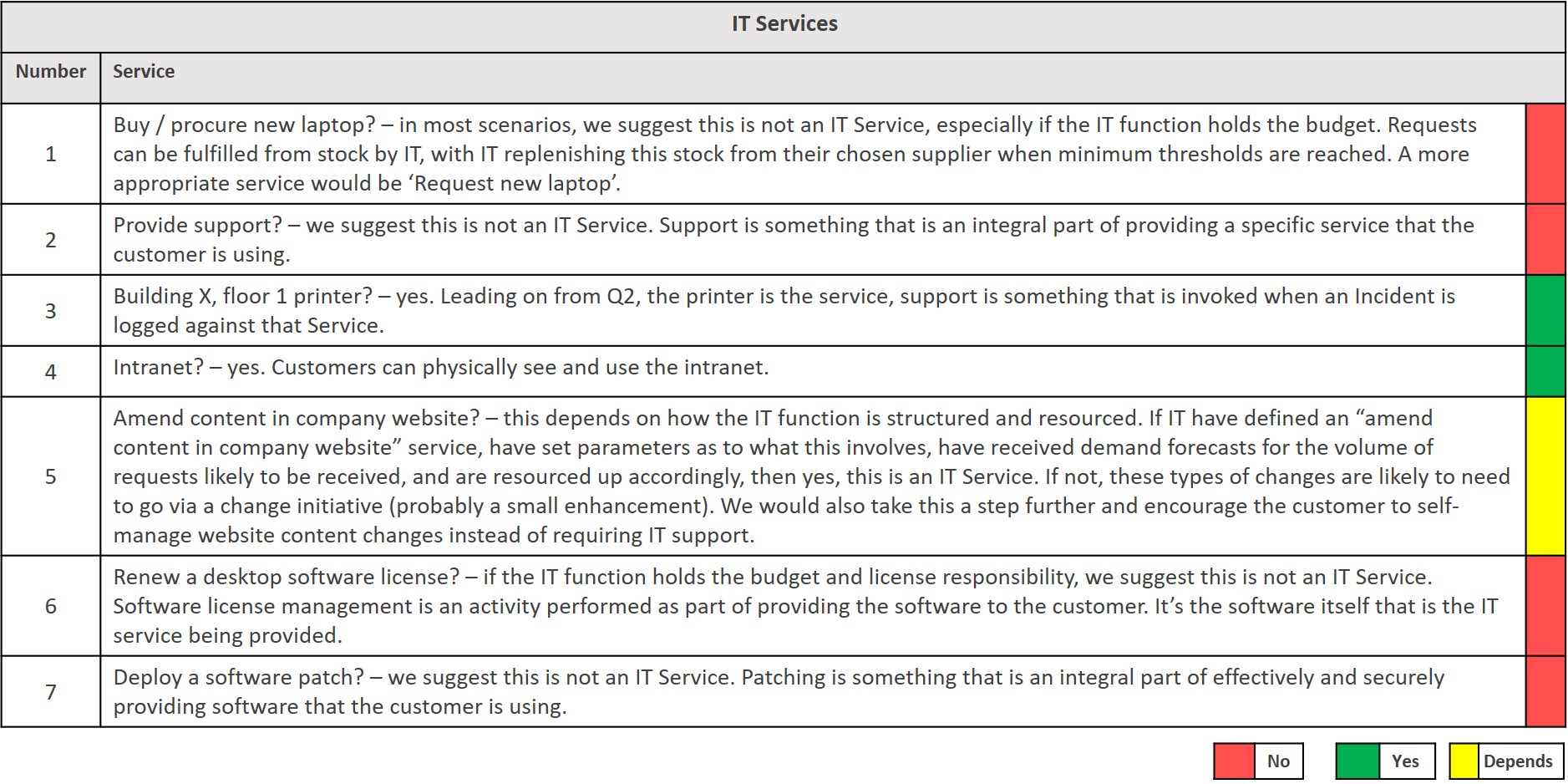What is an IT Service? The 7 categories
Share:
Date:
July 2020

key fact
A well architected, clear and concise Service Catalogue will take the relationship with both your consumers (those that use your services) and customers (those that pay for them) to the next level.
Let us make a reasonable assumption that you have most of, if not all, the 34 IT Service Management practices in place. Incidents are logged and resolved, service requests are logged and fulfilled, changes are reviewed, approved and deployed, patching is performed, knowledge articles are documented, maintained, and used, service levels are defined and reported on, etc.
First of all, this is a huge achievement in itself and will no doubt be benefiting your organisation (if you are not at this stage yet, we can help).
What next? How can you leverage the good work you have accomplished to add further value?
Effective ITSM can and should be utilised to help inform business investment decisions, such as expanding the use of a service, investing more in a service, or switching a service off completely (where the costs outweigh the value). There are four key components to this:
- What IT Services do we provide (the Service Catalogue)?
- What are the performance needs (the Service Level)?
- How are IT Services performance (the Service Measures)?
- How much does each IT Service cost (the IT Bill)?
All four elements are crucial, and they all interact with each other. However, the Service Catalogue is foundational. A well architected, clear and concise Service Catalogue will take the relationship with both your consumers (those that use your services) and customers (those that pay for them) to the next level.
To achieve this, we first need to look at the definition of an IT Service:
“A means of delivering value to customers by facilitating outcomes customers want to achieve, but without the ownership of specific costs and risks.”
That’s straight out of the ITIL book. Does this definition help you define your Service Catalogue and deliver value to customers?
We suggest refining this definition to be “What your consumers physically see, use and / or request from you.”
To bring this to life, try the mini quiz below.
You are a leader of an internal IT function providing services to your organisation. Are the following genuine IT services that you would offer?
- Buy / procure new laptop?
- Provide support?
- Building X, floor 1 Printer?
- Intranet?
- Amend content in company website?
- Renew a desktop software license?
- Deploy a software patch?
Now for the answers:
Definitions and examples may not be sufficient to help identify genuine IT services. Looking at the quiz again, you may have identified that there are different types of IT service, each requiring different service boundaries, incident/request workflows, service levels, performance reporting, and charging. For example, would you manage the “Intranet” service in the same way as the “Building X Floor 1 Printer” service? Unlikely.
We recommend grouping these into seven categories, as follows:
- Application IT Services – The consumer visible aspects of an IT Application (e.g. Company Website, HR System, Accounts Payable, Intranet, Email).
- Location Connectivity IT Services – The connectivity / utility services within a location (e.g. City X, Building Y network) that enables consumers to work.
- Location Equipment IT Services – The shared equipment (e.g. printers, conference phones, etc.) within a location that is used by consumers.
- Workplace User Assigned IT Services – The workplace devices (e.g. laptop, tablet, mobile phone, etc.) and workstation installed software (e.g. MS Office) assigned to specific users.
- Automated Report & Data Feed IT Services – The visible standalone reports and/or data feeds that are automatically provided to consumers (e.g. pricing data to a marketplace).
- Department Functional IT Services – The Business Processes operated by IT that provide ongoing functional outcomes directly to consumers (e.g. IT Service Desk).
- Requestable IT Services – The products and services requested by consumers (e.g. laptop, email accounts, drive quota increase, etc.) which are subsequently fulfilled by IT. See next week’s article which will review considerations for defining these services.
Taking the above approach will not only enable you to progress with the other three key components to help inform business investment decisions, but this will also likely transform all other aspects of ITSM, driving further value to your customers.
Mason Advisory has extensive experience in assisting organisations to quickly create and leverage the advantages of an effective Service Catalogue, meaningful SLAs and transparent costing, using tried and tested techniques.
This is the second in a series of three Service Management related articles. Click below to see the other two:
- Article 1 – Navigating how to “get things done” within organisations. It’s time to simplify!
- Article 3 – What’s in your shop window?
Published: LinkedIn
Disclaimer – opinions expressed in the text belong solely to the author, and not necessarily to the author’s employer or organisation.
